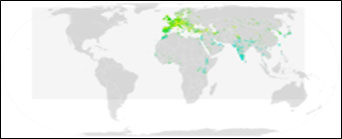
Common Kestrels
"Bombay and Mo" & Meany and Boomerang
In 2018 we decided to try and fly 4 baby kestrels together. We got Eeny, Meany, Miny and Mo. For a year they lived together and hovered together in our shows. At a year old they grew up and decided they didn't like to share their space anymore and began to fight! So we introduced Mo to Bombay and in 2019 they hatched their first chicks. Eeny and Miny found great new homes, along with 3 of the new babies and Meany remains at the Centre to continue to wow our audiences. Boomerang followed a year later and you can fly him on our flying experiences.
Click below to Sponsor "The Kestrels"
COMMON KESTREL FACTS
Falco tinnunculus
TERRITORY/LOCATION
Common and widely distributed throughout Britain. The kestrel has a wide distribution in the rest of the world, from Europe and North Africa, through Eurasia, the Middle East, India, China and Japan.
HABITAT
Prefers open habitat such as fields, heaths, shrubland and marshland. It does not require woodland to be present as long as there are alternative perching and nesting sites like rocks or buildings.
CONSERVATION STATUS
Least Concern

DIET
When hunting, the common kestrel hovers about 10–20 m above the ground, searching for prey, either by flying into the wind or by soaring using ridge lift. It can often be found hunting along the sides of roads and motorways. They are able to see near ultraviolet light, allowing the birds to detect the urine trails around rodent burrows as they shine in an ultraviolet colour in the sunlight, catching mouse-sized mammals. Voles, shrews.
SIZE/WEIGHT
32–50cm long, with a wingspan of 65–82 cm weighing 136–314 g Females are noticeably larger.
NESTING
It is a cavity nester, preferring holes in cliffs, trees or buildings; in built-up areas, common kestrels will often nest on buildings, and generally they often reuse the old nests of corvids if these are available, breeding March – June laying 3–6 eggs.
LIFE EXPECTANCY
10-16 years in the wild
24 years oldest recorded in the wild
SCIENTIFIC
CLASSIFICATION
KINGDOM
Animalia
PHYLUM
Chordata
CLASS
Aves Neornithes
ORDER
Neoaves Falconiformes
FAMILY
Falconidae
GENUS
Falco
SPECIES
F. tinnunculus
DID YOU KNOW?
Most common kestrels die before they reach 2 years of age; mortality up until the first birthday may be as high as 70%. At least females generally breed at one year of age.
The global population is fluctuating considerably over the years but remains generally stable; it is roughly estimated at 1–2 million pairs or so, about 20% of which are found in Europe.
